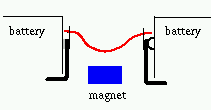 Put the little wire through the two holes in the ends of the battery holder
to make a "swinging bridge" between them.
You will have to bend the wire a little bit
so that it fits (if it isn't bent already!).
Put the little wire through the two holes in the ends of the battery holder
to make a "swinging bridge" between them.
You will have to bend the wire a little bit
so that it fits (if it isn't bent already!).
Assemble these materials:
Cut or break a 6 cm piece of the thin wire. Although it looks
like copper metal, there actually is a coat of transparent paint on the
wire. Scrape off the paint from the last 1/2 cm of each end, using the
little piece of sandpaper or a knife.
Orient two battery holders (with batteries already in them) plus-to-minus,
but then separate them 5 cm apart.
 Put the little wire through the two holes in the ends of the battery holder
to make a "swinging bridge" between them.
You will have to bend the wire a little bit
so that it fits (if it isn't bent already!).
Put the little wire through the two holes in the ends of the battery holder
to make a "swinging bridge" between them.
You will have to bend the wire a little bit
so that it fits (if it isn't bent already!).